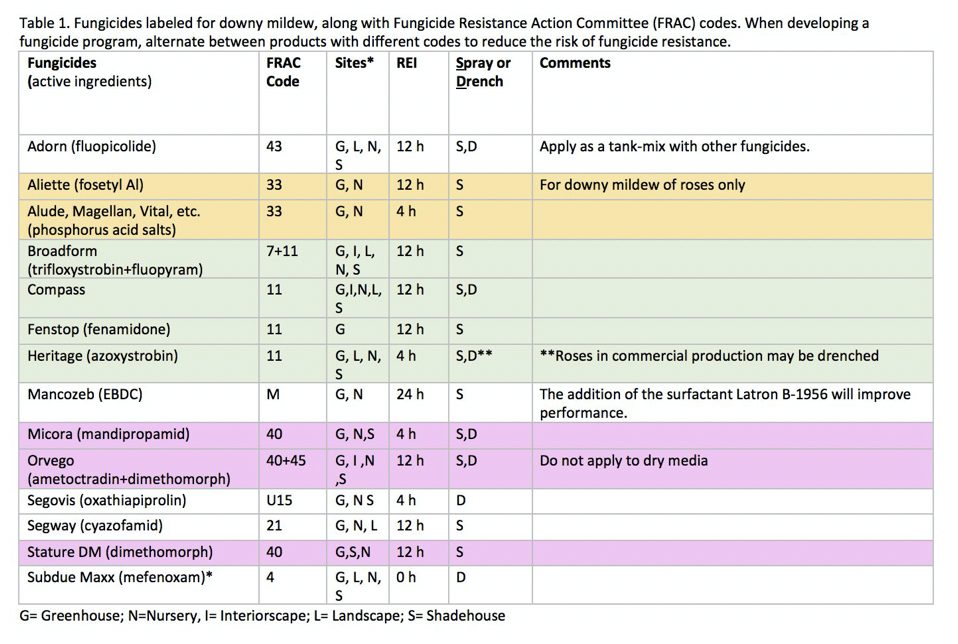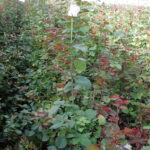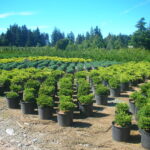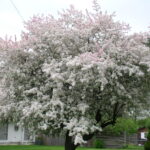For many of us, pest management is never far from our mind. This may be because the pests we manage are always there, and even if we can’t see them, we know that they haven’t disappeared completely.
For this reason, it is important to take a time-out and think about how to improve your management, and begin with the crops that often cause regular problems. We’ll use examples for the greenhouse, nursery and landscape (Table 1)
One of the most cost-effective ways to manage plant diseases is to use disease resistant varieties. Fortunately, we have two publications that list these at Disease-resistant Annuals and Perennials in the Landscape or Disease-resistant Annual and Perennial Production .
Cultural Controls:
For greenhouse and nursery: Increase spacing between plants to reduce humidity in the canopy. Packing plants in tightly may not help your bottom line, or is off-set by the time spent on fungicides and spraying. If powdery mildew is a problem, start off by increasing space between plants and improving airflow with fans. For some crops and pathogens (like PM or Botrytis) spacing helps considerably with disease management, and may even reduce or eliminate fungicide applications. When handling or moving plants, make sure that plants are dry to minimize the risk of injury and inoculation any bacterial pathogens that may be lurking.
For Landscape: Moving trees isn’t an option for most landscapes. Unfortunately, many trees and shrubs are planted too close to houses or fences, reducing airflow and creating some of these problems. Pruning to open the canopy is essential to increase airflow, and improve any fungicide application. If the fungicide can’t get to the intended target (in this case, a leaf or stem for rust or scab), it cannot protect the plant. Evaluate your target plant! Can you cover it successfully? A JD-9 handgun application works great for insects, but it does not provide the thorough coverage necessary for most fungicides.
Scouting:
All of the diseases listed are regular problems in their respective locations. To manage them successfully, make scouting a regular part of your management. Examine plants regularly and carefully, especially the lower, interior leaves where foliar diseases and crown rots get their start.
For greenhouse: For Calibrachoa, start as soon as the cutting are rooted. Fortunately, overhead watering inhibits powdery mildew, so PM is rarely a problem early in the production cycle. However, excessive watering can contribute to Rhizoctonia and other root rots like Thielaviopsis or Phytophthora. When trying to water to prevent powdery mildew, don’t create new problems!
For nursery: With roses (and many other plants), the unfortunate reality is that the misting during propagation that suppresses powdery mildew and aids in rooting, also drives downy mildew. Downy mildew, and not black spot or powdery, is the primary problem affecting roses during propagation and production. This problem also gets into the landscape via asymptomatic plants, making downy mildew a much bigger problem than powdery mildew or even rose blackspot or rust. Managing water and scouting are essential to reduce the risk, incident and severity of downy mildew. To control downy mildew, maintaining the relative humidity below 85% will inhibit sporulation on any infected plants while preventing the germination of spores spread to healthy plants. This can be done by venting and heating the greenhouse with dry and warmer air.
In the landscape: Scouting is challenging because of changing clientele and the reality that these are pesticides and not silver bullets. Most problems have progressed for many years before the client noticed them, and regular fungicide applications will take a few years to protect the new growth on a plant and restore it to its former ‘glory’. A greenhouse or a nursery can clean house and sanitize, an option not available in the landscape.
Which, When, How: For all sites, it is critical to know three things: 1. Which plants routinely have problems? 2. When to apply fungicides to prevent those problems? and 3. Having the right equipment to treat problems. Regardless of the industry, only a few ornamental plants will have any need for fungicides. For these plants, scouting is performed to identify the stage to spray and effectively treat to prevent infection. Knowledge of the crop is essential as you need to apply fungicides to prevent infection. If you wait until you see symptoms, or really bad symptoms, you are starting from a losing position.
When you apply fungicides is just as important as where you apply them. Fungicides perform best when applied proactively, before symptoms are widespread throughout the plant. This is true wherever plants are grown, regardless of crop or system.
In the greenhouse, application via a boom sprayer may provide excellent protection early on, but as the crop density increases, fungicides will not penetrate into the canopy, and may not protect the crown or interior leaves, allowing powdery mildew or Rhizoctonia to get a foothold. Increase plant spacing or spot treat with a wand applicator, making sure that the fungicide gets to the interior of the plant, and doesn’t just coat the outside.
- Figure 1. Tight packing of roses and poor sanitation are a disaster waiting to happen in the inside cut flower operation, which was beset with issues of powdery mildew, botrytis and downy mildew.
- Figure 2. Conifer nursery with well spaced plants.
- Figure 3. These beautiful dense clusters of crabapple flowers indicate a tree in need of pruning!
In a nursery, fungicide applications need to compensate for any weather that can reduce efficacy. Heavy spring rains (more than 1”) reduces fungicide residue by 50%, and may require re-application for protection, especially of highly susceptible roses (or lilacs, or ninebark). Spraying over a crop fails to get the fungicide where it needs to be, on the lower, interior leaves of individual plants. To do this successfully means having the right equipment—not just a boom, airblast or tower sprayer, but a backpack sprayer or fogger to spot treat and protect where pathogens get a foothold.
In the landscape, applying fungicides effectively requires that you are aware of where you are spraying. Are there restrictions because of nearby ponds, waterways, public spaces or neighbors? Are you able to actually cover the plant without drift to a protected area? Although there are fungicides to control a number of diseases, trying to cover mature trees may make using these fungicides impractical or even risky.
The application
When using systemic fungicides, be sure to tank-mix with a protectant and alternate with a fungicide with a different mode of action. For powdery mildew control on established, well-rooted plants, rotate a tank mix of chlorothalonil (Daconil; FRAC M5 protectant) with a FRAC 3 fungicide. Choices include Eagle (myclobutanil, GNL) , Terraguard (triflumizole GNL) or Tourney(NL) alternated with a FRAC 7-11 fungicide like Pageant (pyraclostrobin+boscalid), Okestra (pyraclostrobin+fluxopyroxad), Broadform (trifloxystrobin+fluopyram) or Mural (azoxystrobin+benzo…). This rotation will work well with crabapples, when timed just before bloom (pink), after bloom (remember we want to protect blooms and bees!), and then 7-14 days after, to protect against powdery mildew, scab, and rust!
If plants are still being rooted, take care in using FRAC 3, which often have a plant growth regulator effect and inhibit root formation. Other fungicides to consider in the greenhouse include FRAC 5 Pipron (piperalin), or Affirm (polyoxin D, FRAC 19).
As always, experiment with different products to identify what performs best for your situation, while keeping detailed records.
Downy mildew management has become a topic worthy of a full-treatise or three! Here is table to breakdown the different fungicides for downy mildew management.
All photos by Janna Beckerman.



